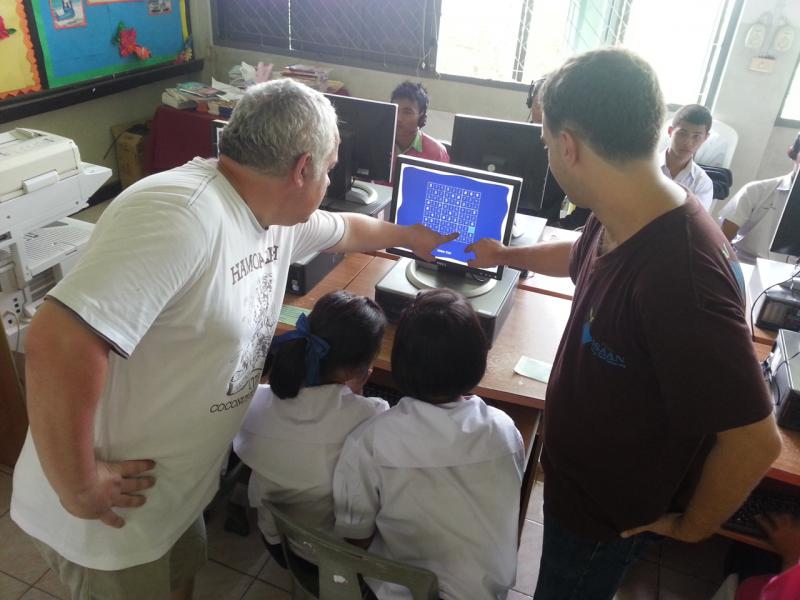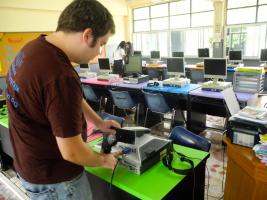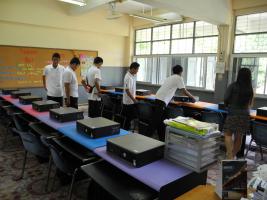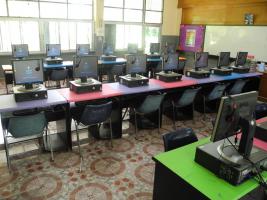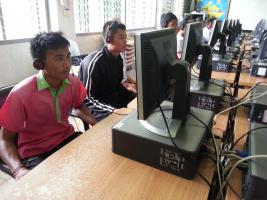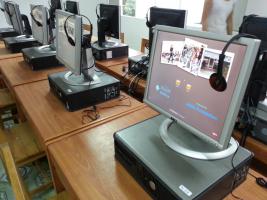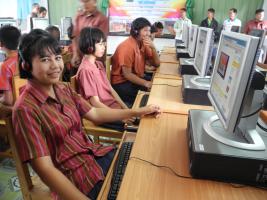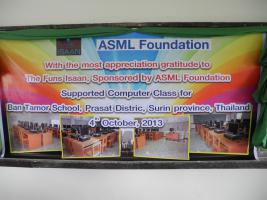IT Classes 2013: Ban Tamor School and Replacements at Saikeaw & Khokyang Schools
- Oct 31, 2013
- Gino
- IT Class
- 0 comments
In 2013, we can continue our IT projects in Thailand with the help of ASML Foundation. This year, we have chosen to replace 2 computer classes installed by Fund Isaan in 2009. Both Saikeaw School and Khokyang school have been very valuable partners to us over the past years. Their dedication to improve the level of education inspired us to continue our cooperation with them. Our original contract, which ended in 2012, specified that Fund Isaan would support their computer class for 3 years. We have opted to provide them with a new computer class, replacing the old one, and again provide support for the coming 3 years.
Saikeaw School has also received numerous volunteers sent by Fund Isaan over the past few years. Their feedback has been overwhelmingly positive, applauding the teachers at the school for their motivation during their job. We have also provided several students of the school with a scholarship, in order to see them succeed at university and in their future careers.
Khokyang School has been a very good partner; we have provided several students of this school with a scholarship. The main reason for re-installing a computer class here has been the skills of the IT teacher and the regular teaching inside the computer class.
This year, we have chosen to install 1 new computer class at Ban Tamor School. We have been working together with this school on our volunteering projects. We have so far sent 1 volunteer and organized an English camp. The next volunteer will arrive during November 2013. The feedback from the volunteer has been overwhelmingly positive, and through direct observation we know this school is well organized, but poorly funded. The school has no computers for students at all, so we wanted to improve this situation. The director is a very intelligent man, who likes to get his hands dirty and help in any way he can. He has been leading this school for over a decade, and even though the school receives little in terms of funds, he has been able to maintain the school’s standing and even improve its infrastructure.
The following paragraphs provide a chronological report of the computer installation activities.
9/9/2013 - Replacements at Saikeaw School
On September 9th 2013, a truck with students from Saikeaw School arrived at the Fund Isaan office in Prasat. They came to pick up the replacement computers, screens and accessories. After loading the school’s truck and our own car full of supplies, we left for Saikeaw School. After a 20 km drive, we arrived at the school and the installation process could begin.Since Saikeaw had received a computer class from Fund Isaan 4 years ago, the first order of business was to take out all the old material and clean the classroom. With the help of teacher Nok and some students, we quickly prepared the classroom to receive the new computers. While the students were wiping down the tables, we began placing and connecting the new Dell computers and monitors. After a small hour of work, everything was connected.
We started up all the computers to make sure everything was in perfect condition. Thankfully, no damage was incurred during transportation and everything started up perfectly fine. After making sure the Internet was operational and the computers could use the Ricoh multifunctional printer present in the classroom, the installation was complete.
Since the new computers came installed with Microsoft Windows 7 and Office 2007, Fund Isaan took some time to explain this new software to the teachers. We explained the differences between the previous Windows XP installation and the new Windows 7 installation and showed how the new Office package works. We also gave a tour of the 3 Fund Isaan educational games (Mathematics, What is it? and Sudoku) and the eLearning for Kids software installed on every computer. After the teachers were informed about the new capabilities of the modernized computer classroom, we invited students inside to come and explore their new computer class for themselves.
Finally we loaded the old computer material into the school’s truck and transported it back to the Fund Isaan office. We later donated this material to a local university.
30/9/2013 - Replacements at Khok Yang School
Early in the morning of the 30th of September 2013, Fund Isaan transported 20 computers, screens and equipment to Khok Yang School. We arrived after a drive of about an hour and enlisted some students to help us carry all the materials to the computer class, on the 3rd floor.First order of business was to remove the old computers and clean the classroom. With the help of some students, we ended up with a clean, but empty computer class after about an hour of work. Installing the new computers took another hour.
When all the material was installed, we made sure all the software and the Internet was working properly. There were some minor issues with the Internet, but after some quick back and forth with the local IT teacher, we managed to get everything up and running.
Finally we explained the capabilities of the new computer class to the IT teacher and showed the new and improved software packages to the teacher and students. We loaded the old computers and screens into our van and the installation at Khok Yang School was finished.
1/10/2013 - New Computer class at Ban Tamor School
Early on the 1st of October, the Fund Isaan team travelled to Ban Tamor School with 20 computers, screens, keyboards, mice and other computer equipment. Ban Tamor did not yet have any computers to help in the teaching of their students, so we were eager to provide them with a fully functional, Internet connected classroom with modern equipment.When we arrived, we noticed the school had already taken care of the electricity and network connections for all the computers, even though we only require the school to take care of the electrical wiring. We carried all the computer materials to the classroom on the 3rd floor (with the help of some students) and began placing and connecting the various components.
After about an hour of work, the classroom was completely installed. While we were working on the computers, the school truck arrived with the multifunctional printer we had asked them to pick up at our office. After carrying this to the 3rd floor as well and connecting it, all the hard work was over.
To be fair, the installation was not without its problems. The school had indeed provided all required network connections, but about half of the network cables were improperly manufactured. We later found out that a local teacher had made the network plugs himself. It took us some time to find the problems and create new network plugs, but thankfully nothing was seriously broken. Also, while the classroom was networked, the school had not yet connected the classroom to the school’s Internet connection. The Fund Isaan team decided to take matters into their own hands, and after a few hours of climbing ladders and navigating dusty false ceilings, the new computer class was connected to the school’s Internet connection through a network cable of about 50 meters.
Now that all the hardware had been taken care of, it was time to show the software to the teachers and students. We began by explaining the various software packages available on the computers, such as the Fund Isaan educational games, eLearning for Kids and Office. We explained how to use the network printer we installed and provided them with a printout of all the important configuration information (passwords and network information).
After the teachers had some time to learn the capabilities of these new computers, we invited some students to join in. We explained them about the games, Office and showed them how easy it was to surf the Internet. After a short while, they all got the hang of it and they were surfing or playing games all by themselves.
This concluded the installation at Ban Tamor School. We made an appointment for a handover ceremony later that week, on the 4th of October and travelled back to our office.
4/10/2013 - Ban Tamor School Handover Ceremony
At 10 AM, between the rice fields of Ban Tamor village, we arrived to a beautifully decorated school where teachers and students alike were awaiting us. In front of the new computer class, the school had arranged a small seating area for us and the school board. A little further down the hall, at least 40 people, mostly parents and students, were seated to watch the ceremony unfold.There were speeches by the school’s English teacher and somebody from the ministry of education. They were in Thai and mostly directed to the visiting villagers, explaining the purpose of Fund Isaan and how the school will use this computer class to improve the education of their students. Our founder, Rony Wuytjens, was invited to make a speech as well, followed by the director of the school, who made a very good effort to speak English and thank us for everything we have done for them.
The ceremony continued with the cutting of the ribbon at the door to the computer class, and a ceremonial first use of the classroom by students. The school also provided us with a certificate and some gifts to thank us.
Durable Recycling
As mentioned in the section concerning the installation of computer classes at Saikeaw and Khokyang school, we replaced 2 old computer classes this year. This left us with a lot of old computer material, some of it in working condition, most of it not. Because we ship new, much more modern material to Thailand every year, we had nu use for these electronics.Unfortunately, there are no durable recycling programs in rural Thailand. What usually happens is that companies throw out their trash, which then gets picked up by locals who will pick it apart and try to sell the scraps. In the case of electronic waste, this can be a very unhealthy and dangerous practice. To avoid such scenarios with our old computer material, we went in search of a method for durable recycling here in Isaan, Thailand.
Through our connection at Saikeaw School (teacher P Nok), we got in touch with P On, a teacher at Rajamangala University in Surin city. He was very interested in these old computers. We explained very clearly that we couldn’t guarantee any components to be in working order, and furthermore, that most computers were completely broken. This did not deter him, and he asked us to write him a letter he could present to the university’s board, describing the total amount of computer materials we would be prepared to donate. We made a letter listing all the old computer materials we wanted to recycle, and provided it to P On during a visit to his university. P On explained to us that he would like to organize class projects where students work with the computers, pick them apart and try to get them working again. Because of the volume of materials we wanted to donate, he was sure the students could at least make a few working computers out of all the parts. He also said he wanted to make display cases with the computer parts that were absolutely broken, in order to provide to primary and high schools to teach younger students about the inner workings of computers. Finally, he mentioned that any parts that still did not find any use, could be dismantled in a safe way at his university’s labs, so the electronic waste could be recycled.
A week later after our visit, P On called us to make an appointment for the pick-up of the materials. He arrived at our office with a few colleagues. We loaded the computers, screens and other materials into his truck and he drove back to his university to start sorting through the materials. We asked him to call us whenever he organizes a class or project with the donated computers, so we can come to check for ourselves how this ‘electronic waste’ had been given a second life.

